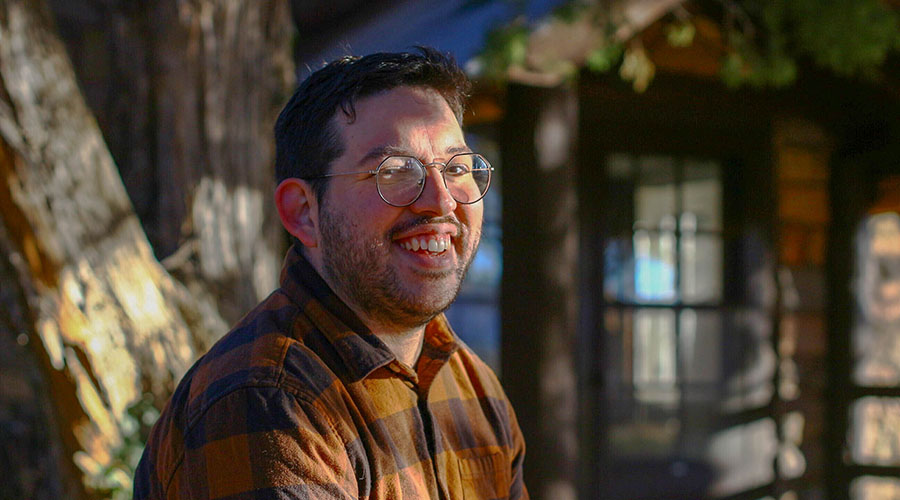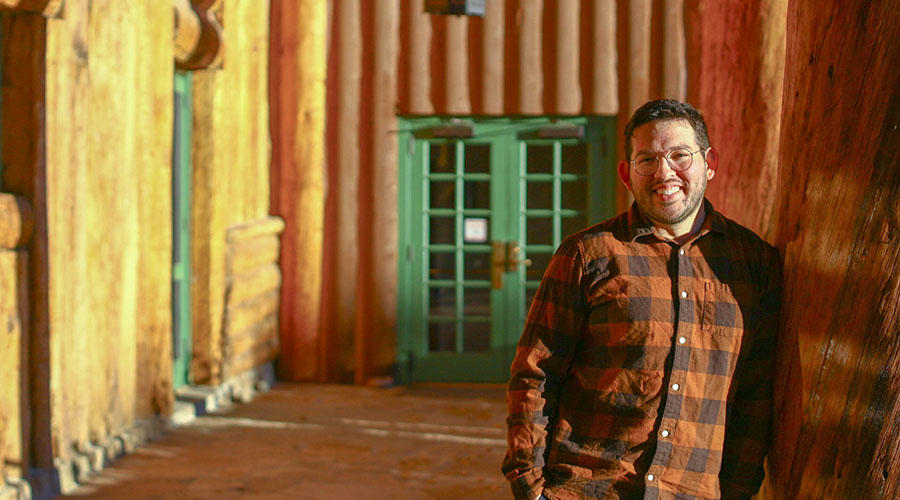From Alabama to Los Alamos, Dylan Funk has always been intrigued by the fourth state of matter.
By Nyla Husain | February 16, 2024

Dylan Funk
By Earthly standards, plasma is an extreme state of matter, most often generated by intensely high temperatures in space — much hotter than it usually gets on Earth. So while plasma makes up more than 99% of matter in the visible universe, it’s less common here on terra firma.
That hasn’t stopped Dylan Funk, a plasma physicist, from spotting it whenever he can. “You see plasmas all over the place,” he says. “Lightbulbs are plasmas because they glow when you put electricity through them.” Lightning and auroras also contain plasma. So do, well, plasma TVs.
When particles in a gas are heated, electrons break free from their atoms, creating the electrically charged matter known as plasma. “Think of [plasma] as a soup,” he says. “The broth is the electrons running around, as well as the ions that they’ve separated from.”
Funk, an APS Bridge Program graduate, and now a plasma physicist at Los Alamos National Laboratory in New Mexico, studied dusty plasma — the “chunks of food” suspended in the plasma soup — as part of his doctoral research at Auburn University. Dusty plasmas are commonly observed in space, he says, in places like Saturn’s rings and planetary nebulae. “If you look at a nebula, you’re looking at the glow from the plasma, but you’re also seeing the dust that’s sitting around the solar system,” Funk says.
The APS Bridge Program, which supports underrepresented students of color as they pursue doctorates in physics, helped connect Funk to the faculty in charge of Auburn’s Magnetized Plasma Research Laboratory (MPRL), Uwe Konopka and Edward Thomas. They later became his Ph.D. advisors and mentors. "From there, [APS] would check in to make sure I was properly mentored and see how school was going," he says.
The MPRL is equipped with a 4-Tesla superconducting magnet, which generates a magnetic field 80,000 times stronger than Earth’s — allowing researchers to investigate how dusty plasmas move in nebulae, and how dust particles could be manipulated in fusion energy reactors.
When he saw glowing plasma in a chamber during his first visit to the MPRL, he was hooked. “All of a sudden, the whole thing’s glowing pink, and then they shine a laser on it and it moves in a way where you can match it to an equation just by looking at it,” Funk says. “You don’t get to see Coulomb’s force in action very often with your own eyes.”
As a Ph.D. candidate, Funk developed a method to measure the charge that dusty plasma collects from surrounding plasma — research he defended for his dissertation and presented at the 2023 meeting of the APS Division of Plasma Physics.

Funk loves New Mexico’s natural beauty. “I do not mind [the commute],” he says.
Funk spent the first few years of his Ph.D. designing laboratory experiments at the MPRL. However, once COVID-19 hit, he switched to computer models that simulate the same physics from the lab — a challenging pivot, he says, but much more interesting.
Funk has lived all over the place, from California and the Philippines in his childhood, to Philadelphia and then Pittsburgh for his undergraduate studies at the University of Pittsburgh, where he majored in physics and first learned about the APS Bridge Program. He found out he’d been accepted into graduate school only a couple weeks before packing up and driving from Pittsburgh to Auburn, Alabama.
“Alabama’s an interesting place to be. You’re close to a lot of history,” he says, noting how close Auburn was to Tuskegee, Montgomery, and Birmingham, where many key events of the civil rights movement took place. “I found a lot of people who were kind to me there, and people who were doing some amazing things.”
Traveling has inspired him, too. He recalls a trip he took to Denver during grad school. During a hike, the crisp mountain air made him wonder what equation describes oxygen differences at high versus low altitudes — an equation he later used to improve his physics simulations. “It was really cool to be able to see something in real life, and then make an equation, and make that equation fit to the code.”
Funk, who’s always been geared towards math and science, draws inspiration from his Ph.D. advisors, who he says helped him navigate the plasma physics community and guide his transition from experimental to computational analyses.
His advice to undergraduate physicists thinking about grad school? “Have an idea of what you want to do with your research earlier on.” But, he adds, “It’s always helpful to be adaptable.”
Although he spent three years working on a laboratory experiment that he never got to build, it wasn’t wasted time, he says. “It’s in my dissertation, and now someone else has built it and they’re doing that research. That’s exciting to me.”
Since July 2023, Funk has been developing simulations for plasma physics research at Los Alamos. “I didn’t expect to like coding as much as I do,” he says. “There’s a certain kind of thought process that goes into connecting the real world with lines on a screen, and I feel myself using [my Ph.D.] every day to connect those dots.”
He’s awed by the history of Los Alamos, the stomping grounds of many scientists who have famous equations named after them — like J. Robert Oppenheimer, whose house he drives by. And he loves New Mexico’s natural beauty. “I do not mind [the commute],” he says. “It is absolutely beautiful. Every single day, I consider stopping to take pictures of the sky.”
Nyla Husain is a science writer based in Washington, D.C.
©1995 - 2024, AMERICAN PHYSICAL SOCIETY
APS encourages the redistribution of the materials included in this newspaper provided that attribution to the source is noted and the materials are not truncated or changed.
Editor: Taryn MacKinney
March 2024 (Volume 33, Number 2)
Articles in this Issue

